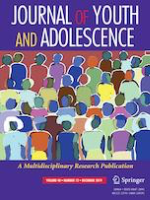
JOURNAL OF YOUTH AND ADOLESCENCE
Scope & Guideline
Advancing insights into youth development.
Introduction
Aims and Scopes
- Adolescent Development and Mental Health:
Research on various aspects of mental health during adolescence, including studies on depression, anxiety, and self-harm, and the impact of familial and social dynamics on these issues. - Social Relationships and Peer Dynamics:
Exploration of peer relationships, including bullying, victimization, and the role of friendships in shaping adolescents' social and emotional well-being. - Cultural and Ethnic Identity:
Studies examining how cultural and ethnic backgrounds influence adolescent identity development, experiences of discrimination, and psychosocial outcomes. - Family Dynamics and Parenting:
Research focusing on the influence of parenting styles, family cohesion, and parent-child interactions on adolescent development and behavior. - Educational Contexts and Academic Achievement:
Investigating the factors that affect academic performance, school engagement, and the transition to higher education among adolescents. - Risk and Protective Factors:
Examination of various risk and protective factors that contribute to resilience or vulnerability in adolescents, including socioeconomic status, community environment, and peer influences. - Interventions and Programs:
Evaluation of interventions aimed at improving mental health, academic engagement, and social skills among adolescents, with a focus on evidence-based practices.
Trending and Emerging
- Mental Health and Well-being:
An increasing number of studies are focusing on mental health issues among adolescents, particularly related to the impacts of social media, peer pressure, and the COVID-19 pandemic. - Intersectionality in Youth Research:
Research that considers the intersection of race, gender, socioeconomic status, and sexual orientation is growing, reflecting a more nuanced understanding of adolescent experiences. - Digital and Online Behaviors:
As technology becomes more integrated into adolescents' lives, research exploring the implications of digital engagement, cyberbullying, and online identity formation is on the rise. - Family Functioning and Parental Influence:
Emerging studies increasingly emphasize the role of family dynamics, parenting styles, and parent-adolescent interactions in shaping youth development and outcomes. - Youth Activism and Civic Engagement:
There is a notable increase in research examining youth activism, civic engagement, and the role of educational contexts in fostering a sense of agency among adolescents. - Cultural Identity and Belonging:
Research focusing on cultural identity, belonging, and the impact of cultural diversity on adolescent development is gaining significant attention, reflecting broader societal changes.
Declining or Waning
- Traditional Gender Roles and Adolescence:
Research on traditional gender roles and their impact on adolescent development has seen a decline, possibly due to shifting societal attitudes and an increasing focus on gender diversity and fluidity. - Substance Use Patterns in Youth:
While substance use remains a critical area of research, there is a noticeable decrease in studies focusing solely on traditional substance use patterns, as newer studies tend to explore broader psychosocial factors and interventions. - Early Childhood Predictors of Adolescent Behavior:
The focus on early childhood predictors of adolescent behavior has waned, with more recent publications emphasizing immediate adolescent experiences and contextual factors. - Bullying Research in Isolation:
Research that examines bullying in isolation, without considering the broader social and emotional contexts, is becoming less frequent as scholars strive for more integrative and contextual analyses.
Similar Journals
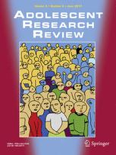
Adolescent Research Review
Exploring the complexities of youth development.Adolescent Research Review, published by SPRINGER INT PUBL AG, is a leading academic journal dedicated to advancing the understanding of adolescent development across multiple disciplines, including Developmental and Educational Psychology, Pediatrics, Psychiatry, and Social Sciences. With an impressive impact factor, this journal ranks Q1 in four critical categories, reflecting its commitment to high-quality research and its influential role within the academic community. Since its inception in 2016, it has become an essential resource for researchers, professionals, and students seeking to explore the complexities of adolescence. The journal not only highlights innovative studies and theoretical advancements but also fosters interdisciplinary dialogue that informs policies and practices surrounding youth. With an assimilative approach to various fields, Adolescent Research Review serves as a vital platform for groundbreaking research that seeks to improve the well-being of adolescents worldwide.
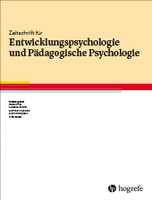
ZEITSCHRIFT FUR ENTWICKLUNGSPSYCHOLOGIE UND PADAGOGISCHE PSYCHOLOGIE
Advancing Knowledge in Developmental and Educational PsychologyZEITSCHRIFT FUR ENTWICKLUNGSPSYCHOLOGIE UND PADAGOGISCHE PSYCHOLOGIE, published by HOGREFE VERLAG, is a pivotal academic journal based in Germany that focuses on the intricate fields of developmental and educational psychology. With an emphasis on innovative research and the latest theoretical developments, this journal aims to bridge the gap between psychological theory and educational practice. It holds a commendable Q3 ranking in Developmental and Educational Psychology and an impressive Q2 ranking in the broader field of Education, underscoring its relevance and contribution to the academic discourse. Although it does not currently offer Open Access options, the journal continues to provide substantial insights and findings that are crucial for researchers, educators, and students alike, thereby fostering advancements in both psychological research and educational methodologies. Spanning topics from childhood development to pedagogical strategies, this journal serves as an essential platform for disseminating knowledge within these interconnected fields.
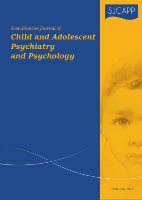
Scandinavian Journal of Child and Adolescent Psychiatry and Psychology
Fostering dialogue for the well-being of future generations.The Scandinavian Journal of Child and Adolescent Psychiatry and Psychology is a premier platform for disseminating significant research in the fields of child and adolescent mental health. Published by SCIENDO, this journal has embraced an Open Access model since 2013, promoting wider accessibility to vital findings and discussions in this pivotal area of study. With a unique focus on issues facing young individuals, it aims to bridge gaps between research, clinical practice, and policy-making. The journal invites submissions from researchers, clinicians, and practitioners worldwide, ensuring a diverse range of perspectives and contributions. By fostering scholarly dialogue and innovation, it plays an essential role in advancing knowledge and improving outcomes in child and adolescent psychiatry and psychology, making it a crucial resource for anyone invested in the mental well-being of young populations.
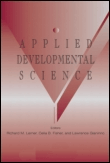
Applied Developmental Science
Fostering knowledge that shapes developmental understanding.Applied Developmental Science is a leading academic journal dedicated to enhancing the understanding of human development across the lifespan. Published by Routledge Journals, Taylor & Francis Ltd, this esteemed journal stands out in its field with a remarkable impact factor and prestigious Q1 classification in Applied Psychology, Developmental and Educational Psychology, and Life-span and Life-course Studies, as of 2023. By focusing on empirical research and innovative theoretical perspectives, Applied Developmental Science serves as a vital resource for researchers, professionals, and students alike, fostering a deep understanding of developmental processes. The journal’s high rankings highlight its influence and commitment to advancing knowledge in developmental psychology. Although not an open-access publication, it provides invaluable insights for those engaged in developmental science, making it a cornerstone for academic inquiry and professional practice within the discipline.
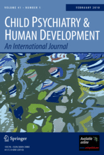
CHILD PSYCHIATRY & HUMAN DEVELOPMENT
Shaping Futures Through Child Psychology ResearchCHILD PSYCHIATRY & HUMAN DEVELOPMENT, published by Springer, stands at the forefront of research in the fields of developmental and educational psychology, pediatrics, perinatology, and child psychiatry. With an ISSN of 0009-398X and an E-ISSN of 1573-3327, this esteemed journal has been a vital resource for academics since its inception in 1970. Currently ranked in the Q1 category across its multiple relevant disciplines, it illustrates a significant impact with its Scopus rankings, placing it within the top 13% for pediatrics and child health and the top 18% for developmental psychology. Its comprehensive scope ensures that leading-edge studies, reviews, and discourse are accessible, contributing greatly to the understanding of mental health and developmental processes in children. With no open access option, the journal maintains a commitment to high-quality, peer-reviewed content that is invaluable for researchers, healthcare professionals, and students alike, as they strive to advance their knowledge and practices in child psychology and human development.
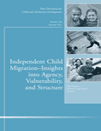
New Directions for Child and Adolescent Development
Exploring innovative pathways for youth growth and learning.New Directions for Child and Adolescent Development, published by Wiley-Hindawi, is a leading journal dedicated to advancing knowledge in the fields of child and adolescent psychology, educational development, and social psychology. With an impressive Q1 ranking in multiple categories—including Developmental and Educational Psychology and Social Psychology—this journal stands at the forefront of research innovation, making significant contributions to understanding developmental processes and challenges faced by children and adolescents. The journal spans a comprehensive publishing history from 1978 to 2023, allowing for a rich dialogue among researchers, practitioners, and students eager to explore emerging trends and methodologies. Researchers can access a wealth of studies and theoretical frameworks, enhancing the journal's stature within the academic community. New Directions for Child and Adolescent Development remains an invaluable resource for anyone committed to improving the lives of younger populations through evidenced-based practices and policies.
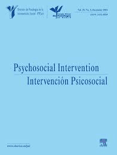
Psychosocial Intervention
Transforming research into practice for global impact.Psychosocial Intervention is an esteemed academic journal devoted to the field of psychology, published by the COLEGIO OFICIAL PSICOLOGOS MADRID. With a strong commitment to advancing knowledge since its inception in 1992, this Open Access journal provides a platform for researchers and practitioners to disseminate their findings and insights. Recognized for its rigorous standards, Psychosocial Intervention has achieved impressive rankings in 2023, being placed in the Q1 Quartile for Applied Psychology, Developmental and Educational Psychology, and Social Psychology, reflecting its leading status in the field. Furthermore, the journal holds commendable rankings in Scopus: Rank #31 in Developmental and Educational Psychology and Social Psychology, and Rank #40 in Applied Psychology, showcasing its contribution to impactful research. This journal not only serves as a vital resource for the academic community in Spain but also positions itself prominently on the international stage, encouraging collaboration and dialogue among scholars seeking to enhance psychosocial practices and interventions.

Universitas Psychologica
Fostering academic discourse in the heart of Colombia.Universitas Psychologica is a vital academic journal published by the Pontificia Universidad Javeriana, Facultad de Psicología, situated in the vibrant city of Bogotá, Colombia. Since its inception in 2007, this journal has been dedicated to advancing the field of psychology through rigorous peer-reviewed research and innovative insights. With an ISSN of 1657-9267, it serves as a repository for a wide range of psychological studies, focusing on both conventional methodologies and emerging trends in the discipline. Despite holding a Q4 quartile ranking in general psychology and social psychology for 2023, its commitment to nurturing scholarly discourse and fostering an academic community remains unwavering. Universitas Psychologica emphasizes open accessibility to its content, making significant research available to a global audience. As it converges towards 2024, the journal continues to aim for heightened visibility and influence within the research community, aspiring to support the next wave of psychological scholarship.
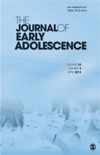
JOURNAL OF EARLY ADOLESCENCE
Advancing Understanding of Early Adolescent DevelopmentJOURNAL OF EARLY ADOLESCENCE, published by SAGE PUBLICATIONS INC, serves as a vital resource for researchers and practitioners in the fields of developmental psychology, education, and sociology. With an impressive history dating back to 1981 and a scope that spans pivotal studies on the social and emotional development of adolescents, this journal has carved a niche in advancing knowledge and understanding in early adolescent development. The journal boasts a notable impact factor, underscored by its Q2 ranking in Developmental and Educational Psychology and Life-span and Life-course Studies, along with a Q1 ranking in Sociology and Political Science for 2023. Its current Scopus rankings indicate strong scholarly influence, ranking #72/604 in Social Sciences (miscellaneous) and #229/1466 in Sociology and Political Science. Although it maintains a subscription model, the journal is committed to disseminating high-quality empirical research and theoretical articles that support the professional growth of educators, psychologists, and sociologists. Engage with JOURNAL OF EARLY ADOLESCENCE to stay at the forefront of the latest developments and insights in the intricate dynamics of early adolescent life.

JOURNAL OF GENETIC PSYCHOLOGY
Bridging Genetics and Psychology for Lifelong LearningJOURNAL OF GENETIC PSYCHOLOGY, published by Routledge Journals, Taylor & Francis Ltd, stands as a prominent outlet within the fields of Clinical Psychology, Developmental Psychology, and Life-span Studies. Since its inception in 1946, this journal has played a pivotal role in disseminating transformative research that explores the intricate links between genetics and psychological phenomena. With an impact factor that reflects its scholarly rigor and recognition, the journal is categorized in the Q2 quartile across multiple psychology domains, underscoring its significance in advancing knowledge and practical applications in psychological sciences. The journal features a broad range of articles—from empirical studies to theoretical reviews—fostering a vibrant academic dialogue among researchers, professionals, and students alike. Although currently not an open-access journal, it provides robust subscription options for institutions and individuals seeking to engage with cutting-edge research. Whether you are looking to enrich your academic portfolio or stay at the forefront of psychological science, JOURNAL OF GENETIC PSYCHOLOGY remains an essential resource. For more information or to explore our latest issues, please visit our site.